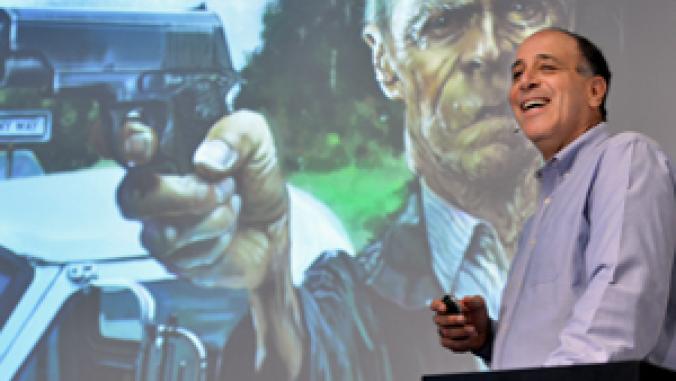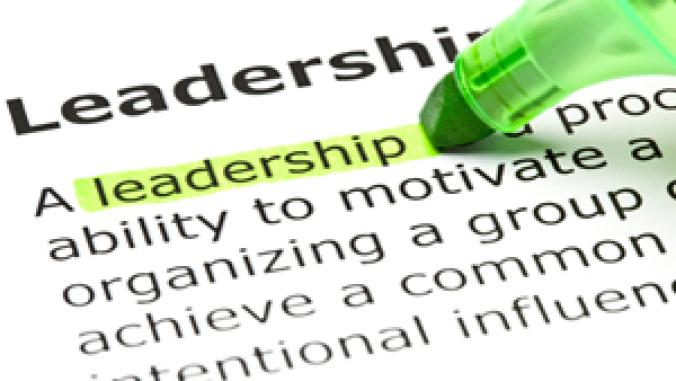What NASCAR Can Teach Sustainability Professionals
<p>NASCAR is a 63-year-old, family-run, privately held company that governs America's No.1 spectator sport -- a showcase for fast cars zooming around racetracks. How is it making green work?</p>

For many sustainability executives, their toughest challenge is to engage employees and persuade them to buy into their company's commitment. Mike Lynch's message is no different, but his toughest audience isn't his organization, industry or its fans. Often, it's his peers.
Recently, the managing director of NASCAR Green Innovation stood before a roomful of sustainability professionals gathered for a meeting of the GreenBiz Executive Network.
Just before he began his presentation, a hand came up in the audience and a voice said, "Before you start, just let me make sure you understand, this whole thing is an oxymoron from our standpoint," Lynch recalled.
"What was great about it," he said, remembering the moment, "was that it was the first time the interaction was so explicit. When I go into a room like that with a bunch of sustainability people, I assume that's the attitude. Because with anybody who is new to the idea [of NASCAR's green efforts], it's usually, 'You're the green guy from where?' "
It's not an unreasonable question. NASCAR is a 63-year-old, family-run, privately held company that's the governing body for America's No.1 spectator sport -- a showcase for fast cars zooming around racetracks. NASCAR doesn't own the tracks, drivers, cars or teams. And it's not pushing its green initiatives with regulations or in contracts. Exactly how is it going -- and doing -- green?
From long practice, Lynch has answers ready. A 20-plus-year veteran in strategic business planning with experience in environmental and health technology, Lynch joined the National Association for Stock Car Auto Racing in 2008 to help define its green strategy and carry the message to the organization's scores of business partners.
 Since then, NASCAR has built the largest recycling program in sports. This year it's on target to divert more than 1,000 tons of material from events -- including cardboard and more than 12 million beverage containers – from landfill.
Since then, NASCAR has built the largest recycling program in sports. This year it's on target to divert more than 1,000 tons of material from events -- including cardboard and more than 12 million beverage containers – from landfill.
NASCAR's success with recycling -- as with all of its sustainability initiatives -- wouldn't be possible without its strategic partnerships. Coca-Cola Recycling is a key partner on recycling, as are Coors Light and Freightliner. The heavy-duty truck manufacturer provides a clean-idle diesel rig that brings Coca-Cola's Portable Processing Center, which can handle 1,100 containers a minute, to race venues.
NASCAR also has robust recycling programs for specialty materials. Official tire sponsor Goodyear recycles about 121,000 tires from NASCAR's top three national race series each year. Environmental services company Safety-Kleen collects and re-refines 180,000 gallons of oil used during races annually. Exide Technologies provides car battery recycling services. Sprint, the sponsor of the NASCAR's No. 1 national race series, offers race attendees postage-paid envelopes for the company's brand-agnostic cell phone recycling service.
 And at the start of the racing season in February, NASCAR launched a multiyear biofuels program that brought Sunoco's Green E15, a blended fuel made with 15 percent ethanol from corn grown in the U.S., to the organization's three major race series – the Sprint Cup, Nationwide and Camping World Truck.
And at the start of the racing season in February, NASCAR launched a multiyear biofuels program that brought Sunoco's Green E15, a blended fuel made with 15 percent ethanol from corn grown in the U.S., to the organization's three major race series – the Sprint Cup, Nationwide and Camping World Truck.
All the cars in 95 races scheduled this year are using the fuel. By season's end, just before Thanksgiving, they will have logged more than 1 million miles with the fuel that results in 20 percent less greenhouse gas emissions than unleaded gas. And drivers and their teams say Sunoco's Green E15 provides a 6 percent to 8 percent increase in horsepower.
That's just part of NASCAR's list of green activities. But the list alone doesn't spell out why sustainability professionals should care about NASCAR's green efforts. Talks with Lynch and other experts in racing, sports and the environment helped bring the big picture into focus from the green perspective.
NASCAR's work to reduce its environmental impact provides unique lessons for companies, especially those that face the same challenge that NASCAR does in its efforts to create change: Namely, problems in credibly conveying green initiatives, and a business model that relies heavily on stakeholder relationships instead of direct lines of authority.
The sport also holds huge potential for popularizing green values and behavior. As the top spectator sport in the U.S. and the No. 2-rated regular season sport on TV, an estimated 75 million people follow NASCAR.
It is an intensely brand-loyal sport. Allegiance to drivers, their teams and companies sponsoring them is "often handed down generation to generation," said Allen Hershkowitz, a senior scientist at the Natural Resources Defense Council who has worked with the entertainment industry and major league sports on environmental initiatives aimed at mass audiences, as well as the vast supply chains for the influential industries.
Next page: How NASCAR's brand loyalty is a corporate sustainability "sweet spot"
Fan loyalty, combined with the ability of sports and entertainment to sway public opinion and habits, can create an immense force for the environmental movement, Hershkowitz said. Star athletes and other celebrities are role models, and clips of them tossing bottles into recycling bins and urging others to do so send a powerful message: Green behavior can be cool and sexy, but most importantly, it's normal.
"If you want to change the world, you don't emphasize how different you are from everybody else," said Hershkowitz.
Brand loyalty is the reason why so many Fortune 500 companies, including several that have their own sustainability programs, sponsor NASCAR, race car drivers and teams. Take a look around the tracks at the logos in the stands, on cars and the drivers' uniforms, suggested Brent Dewar, who led Global Chevrolet at General Motors and is now a senior advisor at the consulting firm GreenOrder. "It's a reflection of America," he said.
That's the sweet spot for corporate sustainability pros.
"We're interested in influencing the supply chain for all those industries," Hershkowitz said, speaking of sports in general and entertainment. Hershkowitz emphasized he and the NRDC have not worked specifically with NASCAR. But he has worked with Roush Fenway Racing (the team that includes NASCAR star Carl Edwards) as part of NRDC's consulting in major league sports.
Both Hershkowitz and Dewar observed that NASCAR usually doesn't get credit for its efforts to ease its environmental impact. "People don't think about that when they think of NASCAR," Hershkowitz said. "Even though NASCAR is gigantic, it's harder to message. NASCAR is a tough lift."
| American Motor Sports' Green History |
| In U.S. motor sports, the IndyCar and American Le Mans series also pursue environmental initiatives. American Le Mans has the most mature programs. It was approached by the U.S. Department of Energy and Environmental Protection Agency about five years ago in an effort to drive innovation in fuel efficiency. American Le Mans has since adopted the EPA’s Green Racing Protocols and conducts two contests during the season that recognize best performance and fuel efficiency with the lightest tread on the environment. Manufacturers are eligible to win the Green Challenge Championship, created by the DOE, EPA and SAE International, a global group of automotive and aerospace engineers. Race teams compete for the Michelin Green X Challenge awards. |
NASCAR and its leaders are acutely aware of its image beyond its fans and the motor sports industry. That awareness informs every element of how NASCAR does green and why it chose to focus its initiatives on waste, emissions and energy.
Here are four key points in NASCAR's strategy:
1. Literally Walk the Walk Before You Do Anything Else
When NASCAR CEO Brian France brought Lynch aboard, the sustainability expert's first move was "to walk every inch of every venue," absorb how NASCAR operates, connect with its many layers of business partners – venues, sponsors, teams and more -- and then build a game plan. It was "almost like a cultural immersion," he said. "You have to be part of it in order to start to understand the nuances and how these gears all fit together." A former member of the Boston Consulting Group, he initially thought, "How hard could it be?"
"It really did take me six months to kind of work my way through it," he said, and even now he keeps in mind that in NASCAR years he is a novice despite his more than two decades as an expert consultant.
Takeaway for Sustainability Pros: On-the-ground, first-hand information is essential.
2. Do First, Talk Later
NASCAR devised its initiatives based on industry knowledge, deep research into its market and identifying key operation areas where it could make a difference. (In NASCAR's eyes, its waste, emissions and energy initiatives share have equal priority, Lynch said.) The organization has a precise idea of where it's going, where it started and how much it needs to do to move the needle. But don't expect to hear much about that for now.
Next page: Why powerful partnerships are the key to NASCAR's successes
"We only talk about and focus attention on initiatives once they're up on their feet and moving along," Lynch said after fielding several questions from me about targets, goals, impacts and stats. "And we only talk about results as opposed to targets or projections."
In large part that's because NASCAR is highly respectful of -- and sensitive to -- its fans, business partners and other stakeholders. "Don't tell me about how fast you're gonna go. Don't tell me how you think you're gonna win. Don't make predictions. Don't tell me about the future with your crystal ball," Lynch said. "That's all interesting. [But] how'd you do? What'd you do? Are you gonna try that hard next time and try to do it again, or even do better? That's what folks in this environment want to hear."
For example, NASCAR spent a lot of time laying the groundwork to make an ethanol blend its fuel of choice. It didn't talk extensively about the program until all its stakeholders were on board and extensive testing indicated that the switch would not only reduce emissions but had a racing benefit as well: more horsepower.
That approach is very much in line with the racing ethos: It's how you finish that counts – a philosophy that applies to sports in general. It's not that sports organizations and key groups that work with them don't have a lot numbers; they do, according to Hershkowitz. It's a matter of how useful that information would be right now to sports' key audience and stakeholders.
Takeaway: Serve your core audience first. Do it in a way that appeals and makes sense to them. Transparency can come later, but don't wait too long.
3. Test with a Time Limit and Double Down (or More) on Stuff that Works
Generally, every proposed tactic for NASCAR's green initiatives is tested on a three-strikes basis, said Lynch. When efforts fail, NASCAR moves on -- so completely that Lynch doesn't talk about them publicly. Measures that pass muster are rolled out incrementally among operations areas.
That's the path NASCAR took with its recycling efforts. All 28 venues for NASCAR's three major race series now participate in event recycling and the volume of recycled material expected this year is five times greater than the amount diverted in 2010.
The organization's clean-air tree-planting program is taking a similar route. NASCAR plants 10 trees for each green flag drop with an aim of offsetting 100 percent of the carbon produced on track during races. Begun in 2009 at 11 tracks, the program led to the planting of more than 1,000 trees last year. Twenty tracks are now participating in the program. While the tally isn't in for 2011, NASCAR is looking to double the number of plantings this year and says its tree-planting program already is the largest in professional sports.
Takeaway: Be firm about pulling the plug on things that don't work. Go big with things that do.
4. Leverage the Power of Relationships

This is the key to how NASCAR's business model and its green initiatives work. Without regulations or requirements serving as a whip for the eco efforts, NASCAR relies on collaboration among its business partners to bring about change.
That may seem blissfully idealistic on first blush, but understanding how NASCAR grew from a relatively small regional sport to a mega-industry, and how it built strong ties among all its players, helps.
"I think NASCAR Nation sees itself and the members of it see themselves as members of a family. When you take that concept, you don't need a long list of checklist requirements," Lynch said. "If you have a track record as an organization and as a sport of having always done your homework, and when you say, 'We think we should go this way,' folks know that you've actually spent the time and really done the work up front to have that be based on something real."
That's where the trust and respect factors among fans and stakeholders come into play.
Takeaway: Strong relationships can trump structure.

The competitive nature of sports and the star-power of top performers are important, too. It's why the Pocono Raceway, with a 3-megawatt solar farm installed last year, now has the largest renewable energy installation of any sports venue, why Infineon Raceway has solar power and thousands of sheep, why a custom paint scheme bearing Richard "The King" Petty's signature decorates the rig pulling Coca-Cola's portable processor for recycling, and why Kyle Busch Motorsports built its new headquarters to LEED standards.
The headquarters hosted the GBEN meeting where Lynch detailed NASCAR's strategy in a private session. At the close of his talk, the GBEN member who had voiced the group's collective doubts to the guest speaker turned to GreenBiz Executive Editor Joel Makower mouthed the word, "Wow."
Top photo CC licensed by El Biffster.





